During our time in Iceland we spent plenty of time doing “research” on Icelandic cuisine and checking out all the must-try foods. Here’s everything we learned about Icelandic food and its history as well as our honest opinions on which foods to try and which to pass on.
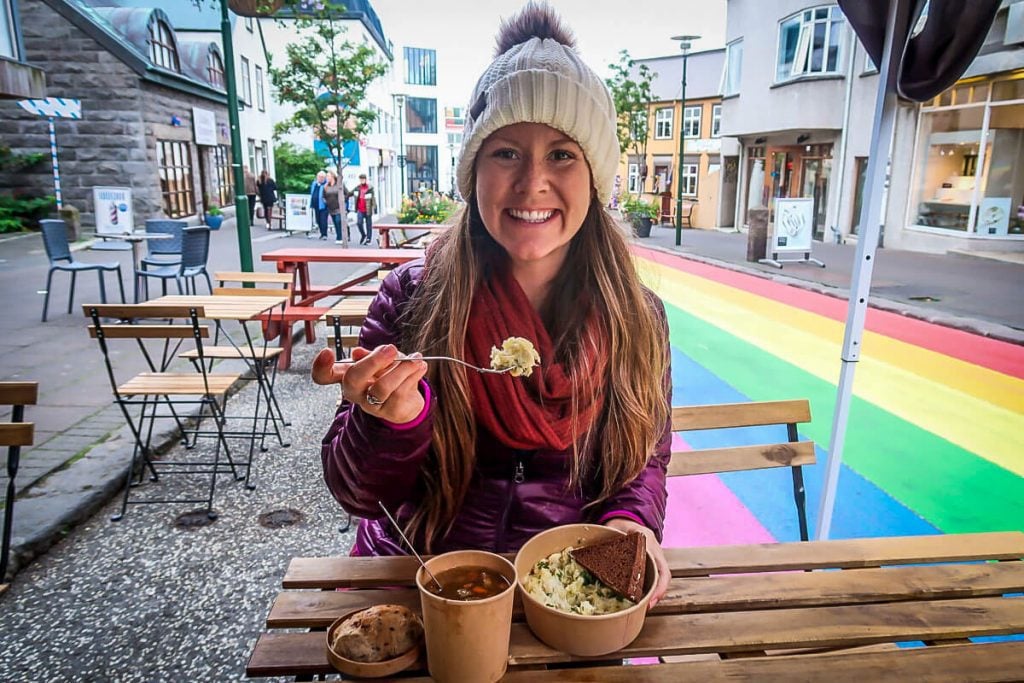
Trying local dishes is one of our favorite parts of travel. We find that we can learn a lot about a culture through food.
Eating our way through Icelandic cuisine turned out to be surprisingly fun, enlightening, and yes, delicious (all in the name of research).
During our trip, we made it a point to try as many traditional Icelandic foods as possible and even joined a Reykjavík food tour to get the full picture.
→ Psst! If you’re interested in doing your own Reykjavik Food Tour (we highly recommend it!), use the code TWS10 at checkout to get 10% off your tour!
We ate at fine dining establishments as well as local hole-in-the-wall joints for a really well-rounded foodie experience. Plus, we got to ask all sorts of questions about Icelandic cuisine to our local guide — all of which we’ll be sharing with you.
In this guide, we’ll break down the Icelandic foods you should absolutely try, share our honest opinions, and flag a few things you can skip—so you know exactly what’s worth ordering when you’re in Iceland.
Before we dive in, you might want to grab a snack so you don’t get hangry! You have been warned.
Icelandic Food Guide
- Traditional Icelandic cuisine
- Modern Icelandic cuisine
- Why is Icelandic food so expensive?
- Icelandic foods to try
- Icelandic sweets to try
- Icelandic drinks
- Foods to skip in Iceland (and why!)
- Best food experiences in Iceland
- Restaurants in Reykjavík
- Tips for vegetarians in Iceland
What is traditional Icelandic cuisine?
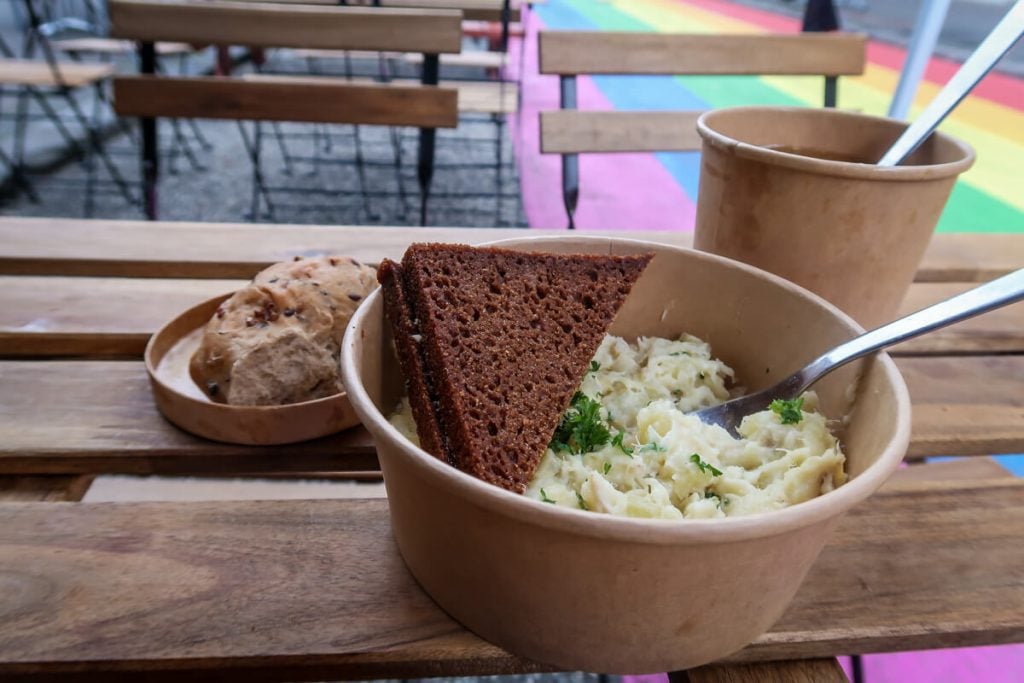
Icelandic cuisine relies heavily upon seafood, which should come as no surprise being that it is an island nation. Other staples you’ll find in Icelandic dishes are lamb, many forms of dairy, potatoes, and hearty breads.
Think fall and winter comfort foods at their finest.
Our honest opinion on Icelandic cuisine
Would we say Icelandic food is some of the best in the world? Umm, not exactly.
If I’m being totally honest, traditional Icelandic cuisine lacks the spices that draw me to Asian cuisines and the freshness of Mediterranean dishes. That said, Iceland is home to some of the best restaurants we’ve had the pleasure of dining at.
Let me put it this way, while I wouldn’t consider Icelandic food to be in my personal “top 5 cuisines” (yes, I have a top 5 list!), we had some incredibly interesting and delicious dining experiences in Iceland.
If you love food, like us, you’re in the right place because we’re going to go over all the must-try Icelandic foods and where to get them.
Modern Icelandic cuisine
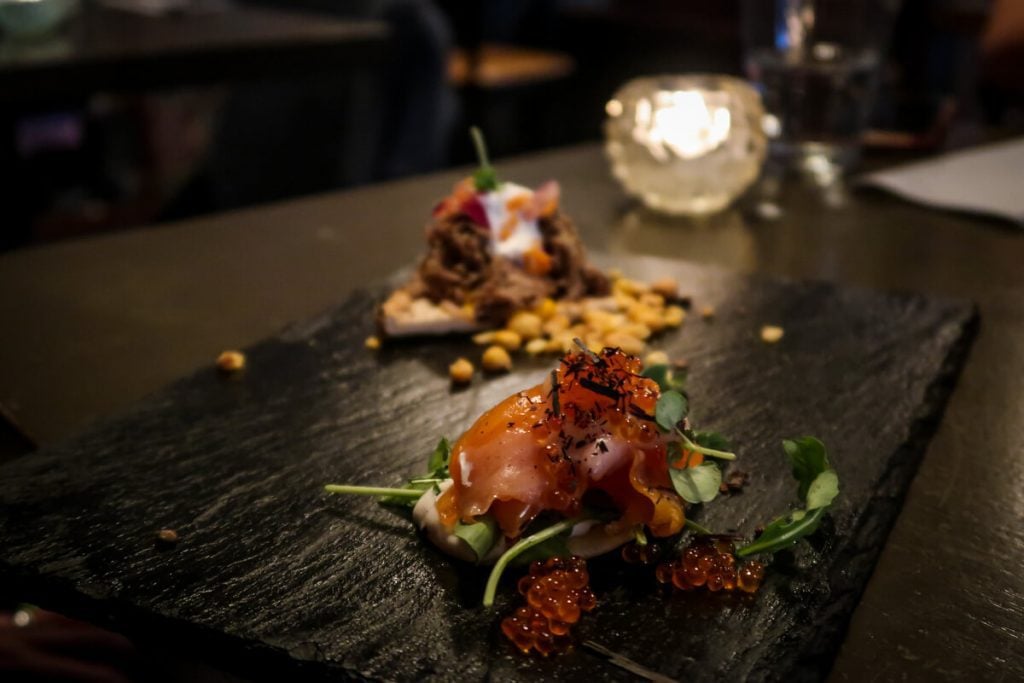
Being that the climate doesn’t allow for year round farming, traditional Icelandic food isn’t very vegetable-focused. That said, with new technology that allows people to harness the power of geothermal activity, greenhouses are becoming a popular and sustainable way to grow and harvest all sorts of vegetables that are not native to this country.
All throughout the country — but most notably in Reykjavík — you’ll find fine dining where the chefs create a special twist on traditional favorites.
Why is Icelandic food so expensive?
In general, the prices of most things in Iceland are quite high. And this is no different when it comes to food. So why the steep prices?
Well, Iceland is an island nation, and therefore many goods need to be imported. This applies to food items themselves as well as agricultural equipment and fuel.
Additionally, being that Iceland’s climate isn’t ideal for growing produce (shocker, I know!), they have to get inventive with how they farm.
In recent years, greenhouses utilizing the power of geothermal energy have made it possible to grow all sorts of non-native food. That said, it requires quite a bit more planning and infrastructure than is necessary in climates more adept at growing fruits and vegetables.
When you really think about all that goes into getting food onto tables in Iceland, the high prices actually make a lot of sense.
→ On a budget? To save money, it’s a good idea to cook as many meals as you can. This is pretty easy if you are camping in Iceland. We’ve even written an entire guide to supermarkets in Iceland, which is packed with money-saving tips for anyone traveling on a tight budget.
Icelandic foods to try
So what should you put on your “must-eat” list while in Iceland?
I’m glad you asked because we’re about to discuss some traditional Icelandic foods and share our honest opinions about each so you know how much effort (and money!) to devote to tasting them.
We’re also sharing our top recommendations for where to try some of these dishes, because sometimes figuring that out is half the struggle.
Calling all foodies!
To help you organize which foods you really want to taste (and which ones you’re okay skipping), we’ve created a free guide. It contains a checklist of must-try Icelandic foods and a list of the best food experiences to have in Iceland!
Download your FREE Icelandic Foods Checklist here:
And now without further adieu, let’s dive into one of our very favorite topics… Food!
1. Lamb
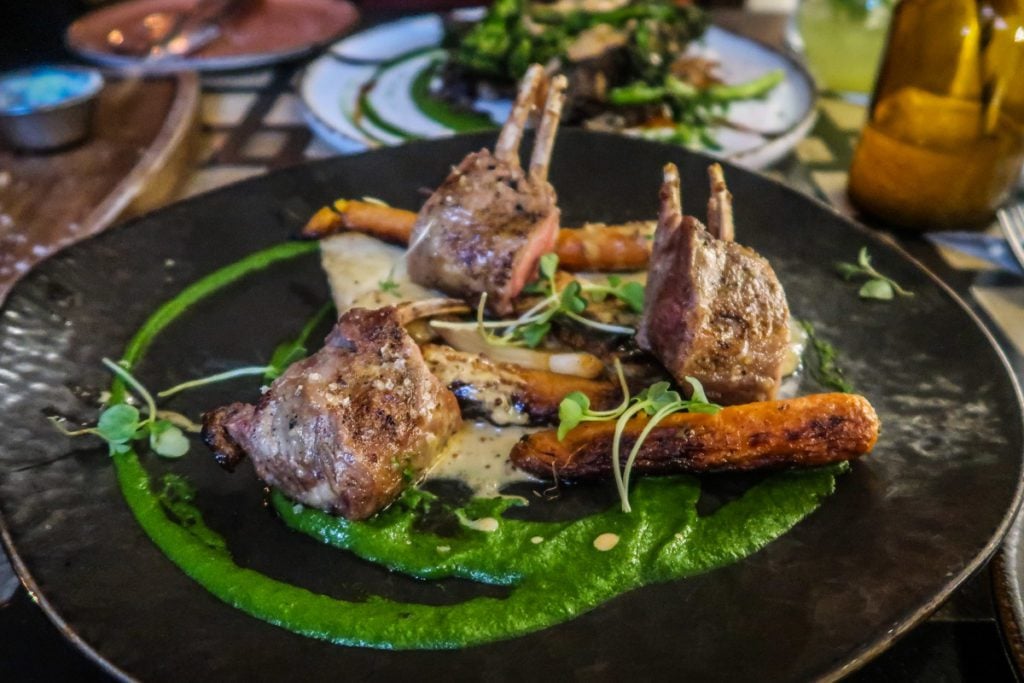
As you drive around Iceland you’ll see sheep everywhere. EVERYWHERE. So it should come as no surprise that lamb is one of the most common things you’ll see on menus around the country.
The sheep in Iceland are typically allowed to roam free, eating wild herbs and grasses, and therefore producing super tender and flavorful meat.
You’ll find many variations of lamb on menus around Iceland – from rack of lamb to lamb stew (more on that later) to smoked lamb (hangikjöt) served on rye bread.
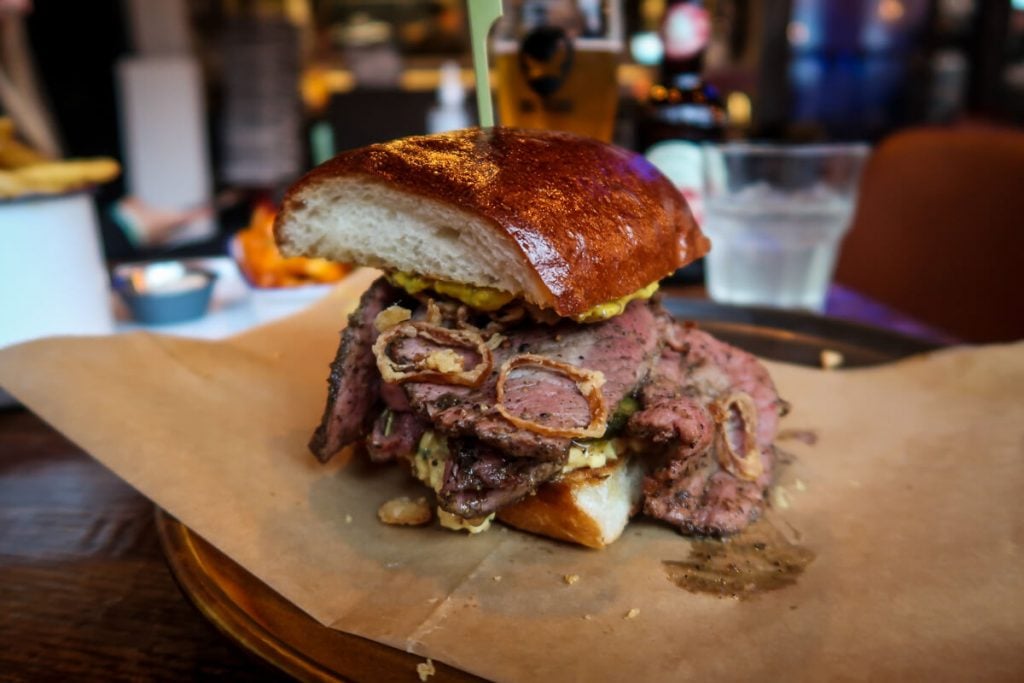
Here are some unique takes on lamb we tried in Iceland:
- “Lambstrami” sandwich: a creative twist on a pastrami sandwich (pictured above) from BrewDog in Reykjavik
- “Lamburger”: If you find yourself in Seydifjordur, make your way to Fancy Sheep (a seasonally-open food truck) for a legendary lamb burger topped with brie, cranberry chutney, bacon, pickled onions, greens and mint mayo.
2. Kjötsúpa
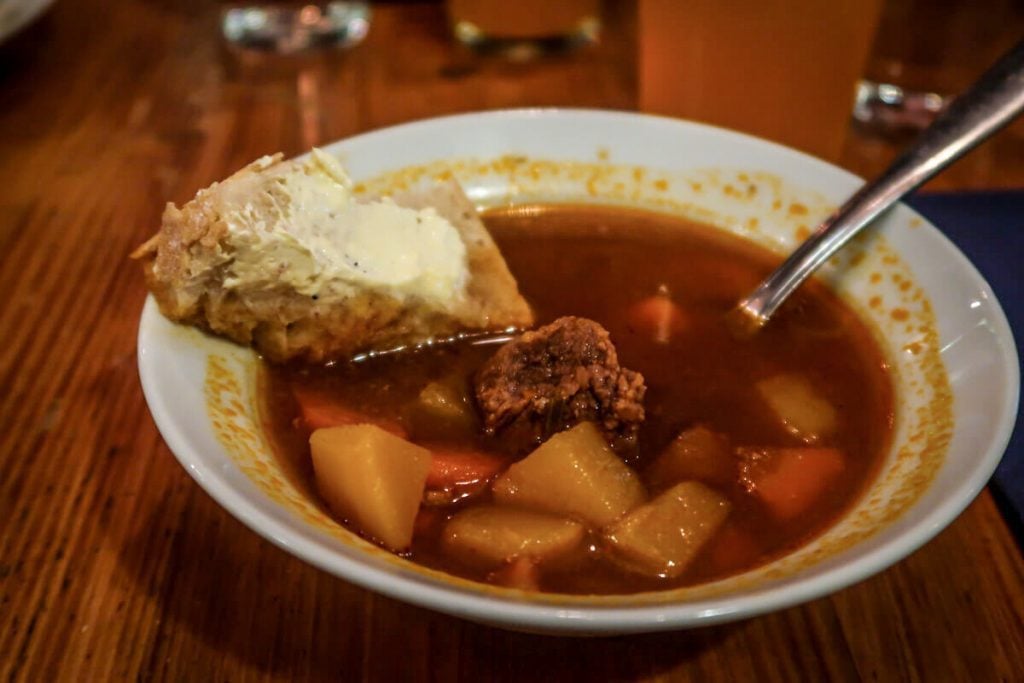
What is it? Lamb stew
Speaking of lamb, this traditional lamb stew is a hearty dish that will please just about any palate (except vegetarians, of course!). With a flavorful broth, onions, carrots, potatoes and generous chunks of lamb, it’s hard to find something more satisfying on a cold or rainy day (especially if it’s served in a bread bowl!).
We can’t deny the deliciousness of Kjötsúpa, but in our opinion, it tastes very similar to hearty beef and vegetable stew we both had growing up in the Midwest USA. It’s definitely a dish to try while you’re in Iceland, but expect it to taste familiar.
Our advice: Don’t just stick with the lamb soup during your trip… order any that strikes your fancy. Icelanders do soup really well. And while we really enjoyed the Kjötsúpa, there were other soups that we liked just as much (if not more!), so sample away!
3. Plokkfiskur
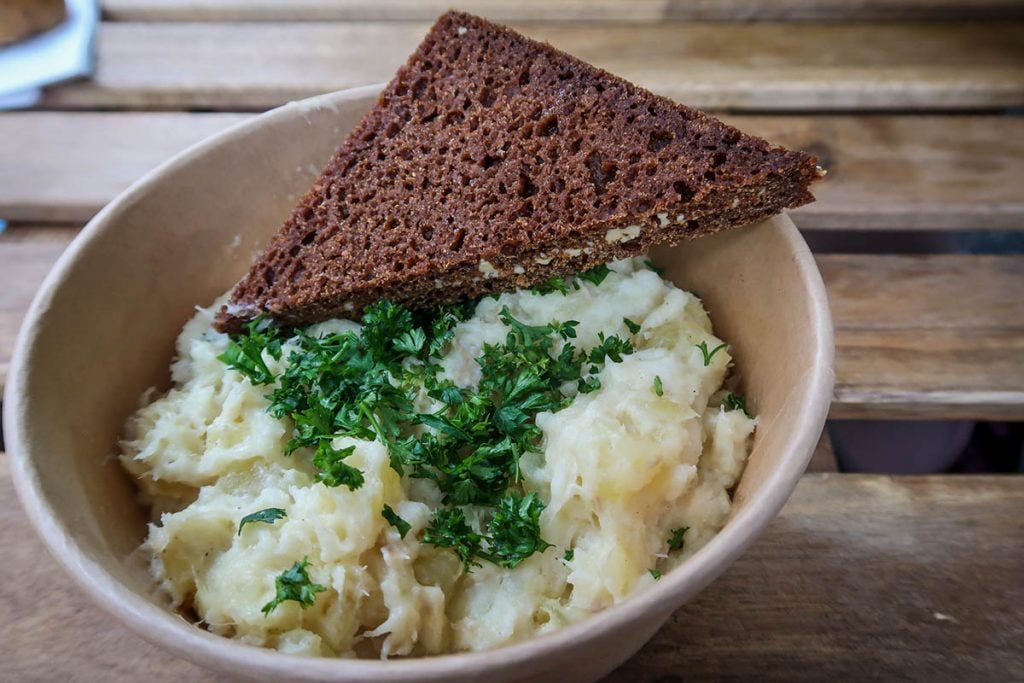
What is it? Fish Stew… sort of
Often referred to as “fish stew”, I personally think this description is a bit misleading, as it’s not really similar to a soup at all. This dish is more similar to a gratin, and is pretty simple as it only has a handful of ingredients.
Boiled whitefish (like cod or haddock) is mixed together with smashed potatoes, milk and seasonings. It is typically served with rye bread and a hearty smear of butter for the ultimate carb-heavy comfort meal.
This dish is a staple in a lot of Icelandic households, and many families have their own take on the recipe. For those less inclined to cook, it’s possible to buy plokkfiskur from a fish market and bring it home to bake for a simple yet hearty meal.
Where to try it: We tried plokkfiskur at two different Reykjavík restaurants and each version was a little different. Reykjavík Street Food’s version is good for those traveling on a budget, while Messinn’s is a little fancier (with a price tag to match).
4. Langoustines
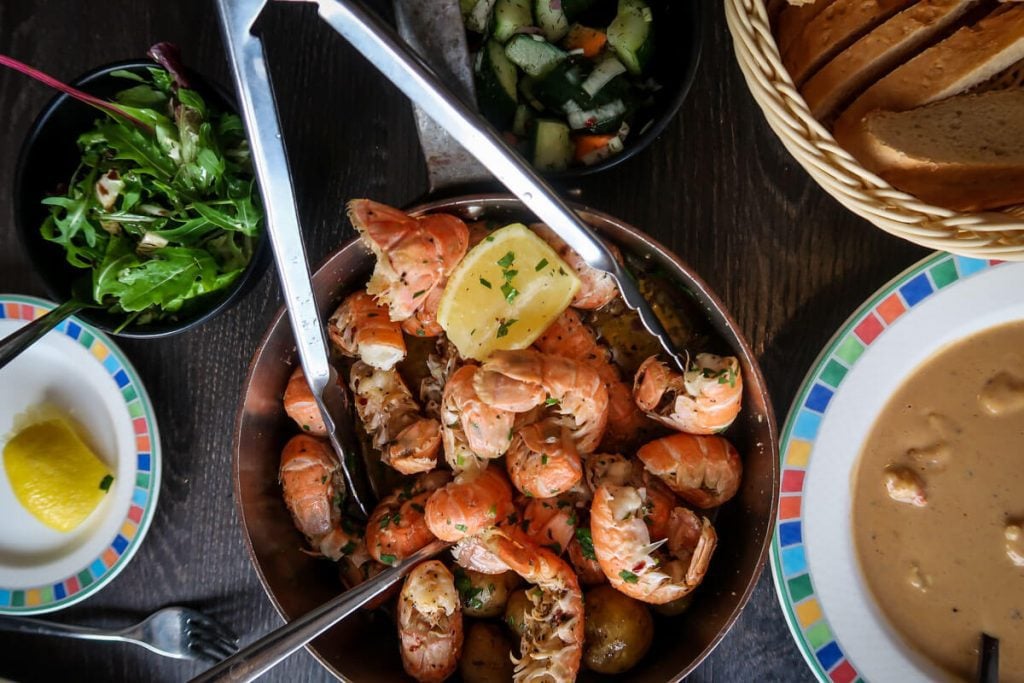
What is it? Shellfish similar to a shrimp or tiny lobster
Often on menus as “Icelandic lobster” these shellfish taste like a cross between a shrimp and a lobster. I guess it goes without saying that if you’re a seafood lover, you’ll find them to be pretty darn tasty!
How do you eat langoustines? Any way you can!
- Langoustine soup.
- Grilled langoustines.
- Langoustine sandwich.
Anyone else getting flashes of Bubba Gump?!
We tried all of the above renditions during our trip in Iceland and really enjoyed them all, but if you’re going to choose just one, grilled langoustine is the way to go (and we’ve got an amazing restaurant recommendation for you!).
Where to try langoustines: While researching restaurants in Iceland (yep, we really planned out our meals so we could try the best of the best!), we came across multiple recommendations for Fjöruborðið. This seaside restaurant just about an hour’s drive from Reykjavík is known for one thing – langoustines. The menu is small, but the dishes they offer are spectacular.
You can order a three-course meal, which includes langoustine soup, grilled langoustines, and dessert for around $80 – $90 USD per person (depending on what size you order).
Or to save a bit of money, you can order a large portion of the grilled langoustines (you won’t regret the large size!) and a large langoustine soup to share between two people. We did this and were fully satisfied. The grilled langoustines are out of this world delicious.
Insider tip: Reservations are highly recommended. We booked a table and on the night we visited, it would not have been necessary. However, it’s better to be safe.
5. Rye Bread
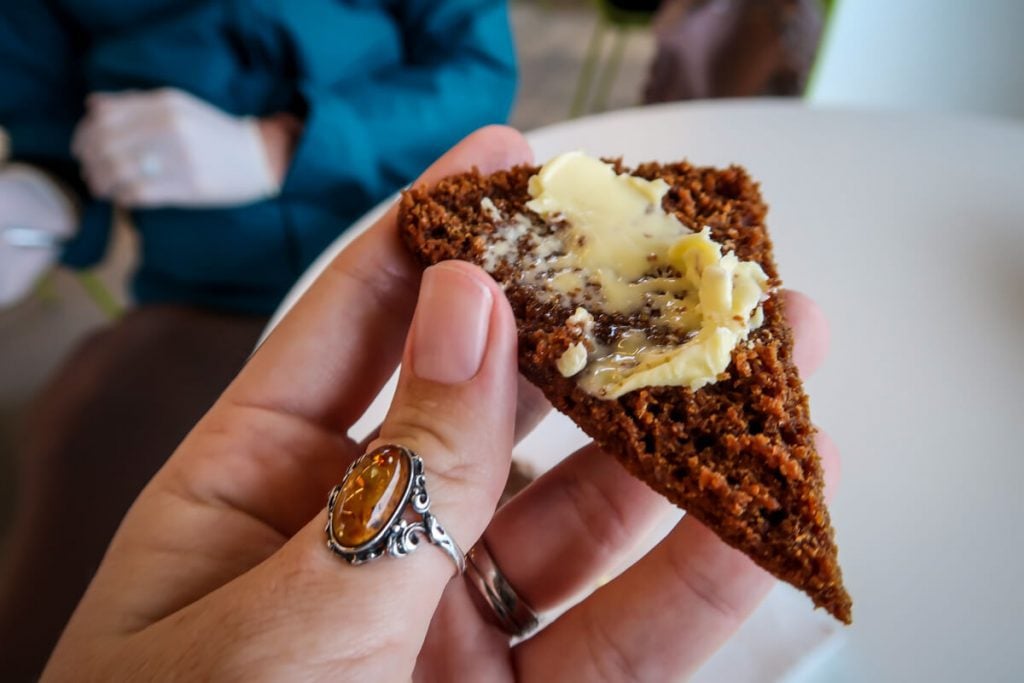
What is it? Dark, dense and slightly sweet bread
If you’re thinking this sounds boring, let me stop you right there. The rye bread in Iceland is next level (at least compared to any rye bread we’d ever tried before).
We were told there are two types of rye bread in Iceland — a sweet type and a sour one.
Topped with a generous amount of smjor (aka Icelandic butter), this stuff is what dreams are made of.
Where to try it: We booked a rye bread tasting through the Geothermal Bakery at Laugarvatn Fontana where they bake the bread underground using geothermal energy.
The tour was really interesting and was a nice addition to our Golden Circle route. But the best part was the bread — oh my goodness was it delicious!
We did have someone reach out and say they did a similar tasting experience near Lake Myvatn but the bread didn’t turn out very good, so we’d highly recommend sticking with the one at Laugarvatn Fontana.
6. Pylsa

What is it? Icelandic Hot Dog
Oh, the famous Icelandic Hot Dog… We couldn’t make a list of Icelandic foods and not include this one. Truthfully, I’m not a huge “hot dog person”, but I was very impressed with Iceland’s version.
Even if you’re like me and don’t totally love the idea of tube-shaped meat, pylsa definitely deserves to be tasted (at least once) during your trip to Iceland.
So, what’s so special about Icelandic hot dogs anyway? I wondered the same thing.
For starters, the hot dog itself is typically made with 80% lamb and 20% pork/beef (or, as one local said, “we don’t worry about that 20%).
Now let’s talk toppings! This hot dog ain’t your average ballpark weenie (okay, I hate that word; sorry for using it!). A true Icelandic pylsa comes topped with the following:
- Sweet brown mustard called pylsusinnep
- Rémoulade (a mayonnaise-based sauce with herbs and spices)
- Fried, crispy onions
- Raw onions
- Icelandic ketchup (made with apples instead of sugar)
Our advice is to order your dog fully loaded with all the toppings!
Where to get it: The most famous place to sample pylsa is at Bæjarins Beztu Pylsur, an unassuming stand in Reykjavík whose name translates to “the best in town”.
While not a secret by any stretch, stopping here to sample the one thing on their menu – plysa – is a must for all carnivorous travelers in Iceland.
In operation since 1937, this stand often has long lines of both locals and tourists. As the city has developed, the owners have been asked to move their stand to another location, but they have declined and remain in the same spot they’ve occupied for nearly a century.
Fun fact: Bill Clinton famously ate here in 2004 and ordered his dog with nothing but mustard. Take our advice and don’t order a “Clinton Dog”. Get yours with all the fixings to experience the full range of toppings.
You can also try pylsa all around the country, as they are a staple at gas stations. Yep, that’s right, gas station hot dogs are a big deal in Iceland.
But don’t compare them to the ones you might see in other countries, spinning around in a heated cage until they turn wrinkly. The ones in Iceland are next level, though they’re not exactly cheap.
→ Looking for more things to do in Reykjavík? We’ve put together the ultimate guide to Reykjavík with all the information you’re looking for!
7. Skyr
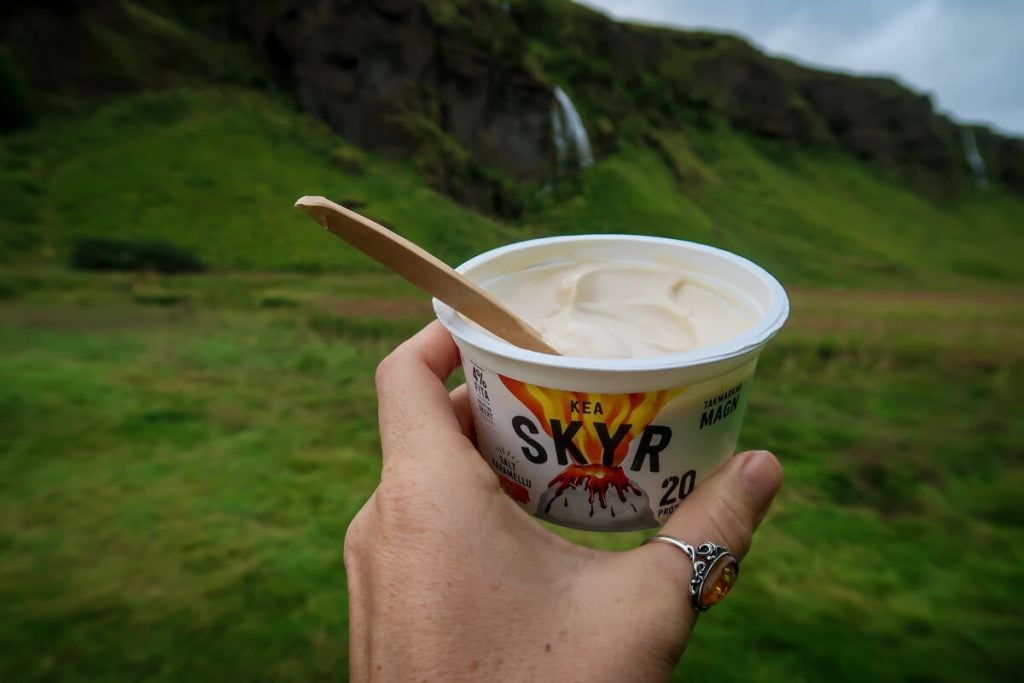
What is it? A dairy product that is very similar to Greek yogurt
Icelanders love their skyr, and once you taste it you’ll see why! I’ll be honest, I think it tastes nearly identical to high quality Greek yogurt (which I love!), so it’s not anything too different from what you may be used to.
Compared to regular yogurt, skyr has much more protein (up to 17 grams!) and less sugar. It is also much thicker than traditional yogurt, and the unique Icelandic cultures used to make skyr give it a flavor that is more creamy than tart and sour.
Fun fact: Supposedly, the way that skyr is made means that it is technically classified as a cheese, but again, expect something much more similar to yogurt than cheese.
Skyr makes a great snack or breakfast for your on-the-go adventures in Iceland, so pick up a few flavors from the supermarket so you can find your favorite.
Where to try it: All Icelandic supermarkets will have a pretty decent selection of skyr to choose from, so go crazy and try a few! Also, if you see a skyr dessert on a menu somewhere, give it a try as it is really tasty. Think of it as a light cheesecake mousse!
8. Arctic Char
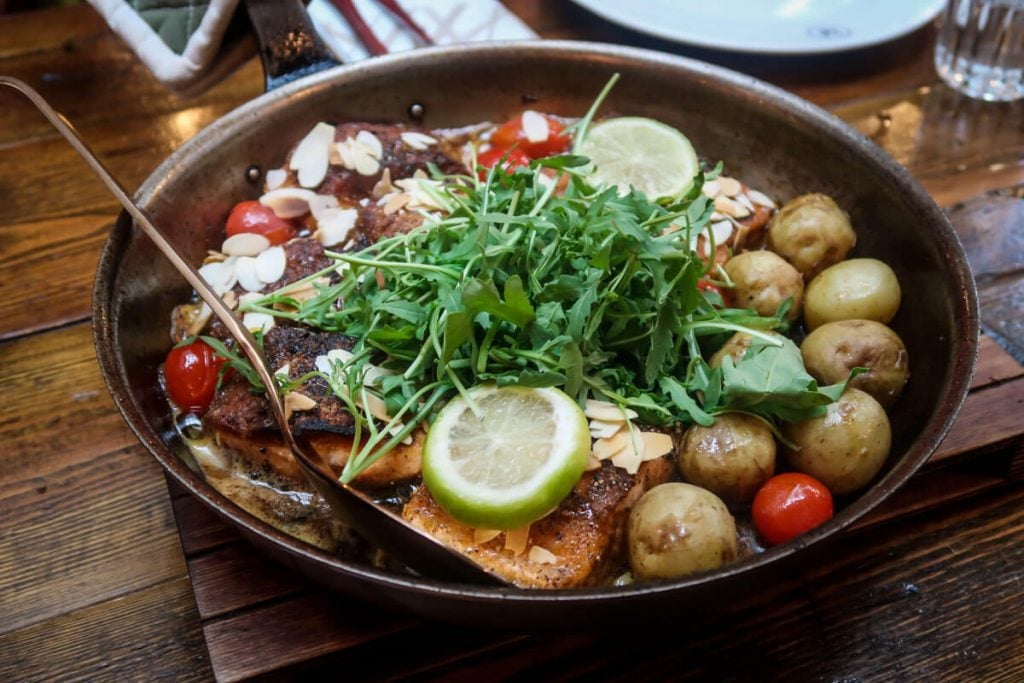
What is it? Cold-water fish commonly found in Arctic waters
Similar in texture and flavor to both salmon and trout, this fish is popular on Icelandic menus. With pinkish flesh and a mild flavor, Arctic char is worth trying at least once on your Iceland travels.
Depending on what type of restaurant you order it at, this fish may be seasoned and served in all sorts of ways, but we’d highly recommend reading our suggestion in the “where to try it” section, as we think this restaurant did a phenomenal job.
Insider tip: Not seeing Arctic char on the menu? Don’t stress. One local we met recommended ordering the fish of the day at just about any restaurant serving seafood. They said that’s their go-to dish and it’s usually one of the less expensive options and typically very delicious. It may be Arctic char or perhaps a different type of fish, but either way, you’ll know it’s fresh!
Where to try it: We had Arctic char at Messinn (located in Reykjavík) and were thoroughly impressed. It was cooked to perfection and so incredibly tasty, and we’d highly recommend trying their version. Just be sure to make reservations.
Psst! If you plan to do a Reykjavík Food Tour, this is one of the stops on your tour! Remember to use code TWS10 at checkout to get 10% off your tour!
9. Harðfiskur
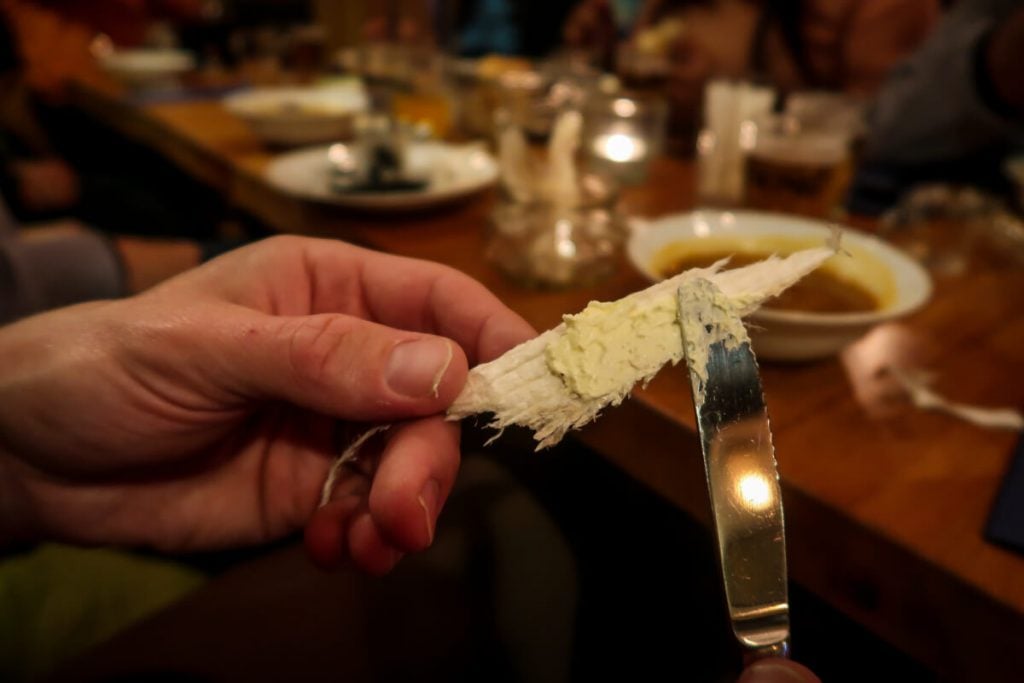
What is it? Dried fish “jerky”
Harðfiskur translates to “hard fish”, and it’s just that – hard, dried fish. Kind of like a seafood version of beef jerky.
This popular fishy snack was born centuries ago as a way to preserve a fresh catch and make it last longer. While this dish used to be especially popular for working-class families, it is now a popular (and kind of pricey!) snack with most of the Icelandic population.
Traditionally, a whitefish like cod, haddock or wolfish is salted and hung from wooden beams and left out to dry in the wind. It is then pounded to give it a texture that is more flaky than tough.
Today, it is also commonly dried with fans or in ovens, which is much more efficient, though it is said to produce a less tasty final product.
This snack is super high in protein, making it a pretty healthy option (if you look past the salt and don’t layer it with butter!).
Local tip: We were told that harðfiskur is best with a generous scoop of butter. And we preferred it with butter instead of plain.
Our opinion: Personally, we’re not huge fans. While teaching English in Korea, we tried dried fish over and over again (as it’s very common in that part of the world, too). Even though we both love fish, this is just a little too fishy for our tastes. Don’t let our opinion stop you from trying it – many people love this stuff. Give it a go and see what you think.
Where to try it: We got little samples at a flea market in Reykjavík as well as during our Reykjavík Food Walk tour. If you really like it, you can buy a whole bag at just about any Icelandic supermarket for around 1,200 ISK ($9).
10. Fish and chips
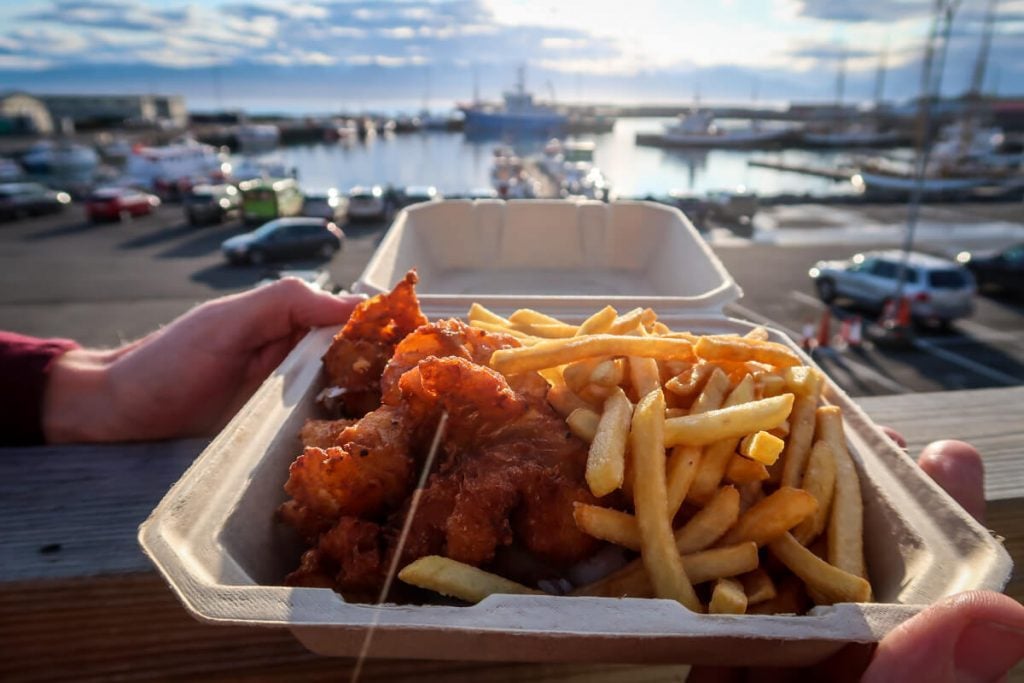
While fish ’n chips is more of a British dish than an Icelandic one, you’ll find plenty of amazing fish and chips shops around the country serving up fresh catch of the day, battered and deep-fried, of course!
Instead of the white tartar sauce (made of mayo and relish) that we’re used to, we noticed a lot of the fish and chips shops in Iceland served it with a “kocktail” sauce that is kind of like an aioli. This is something you typically have to order separately at an additional charge.
Where to try it: We had fish and chips a few times during our trip in Iceland, but our favorite was at the aptly-named Fish and Chips in Husavik, which is only open in the summertime. If you eat here, one portion should be enough for two people to split (it was for us, and we’re big eaters!).
If you’re in Reykjavík, there are a couple of notable places to try fish and chips:
- Kaffivagninn: Apparently, this is the oldest restaurant in Iceland, and they are known for excellent fish and chips and fish stew.
- Fish and Chips Vagninn: This food truck is located near the pier and serves up generous portions of fish and chips with house sauces.
Icelandic sweets to try
If you’ve got a sweet tooth, you’re in luck because there are many treats and desserts unique to Iceland.
Many coffee shops and cafes have excellent cakes and pastries, so try whatever strikes your fancy. But if you’re looking for something authentically Icelandic, keep reading for some tips.
11. Licorice
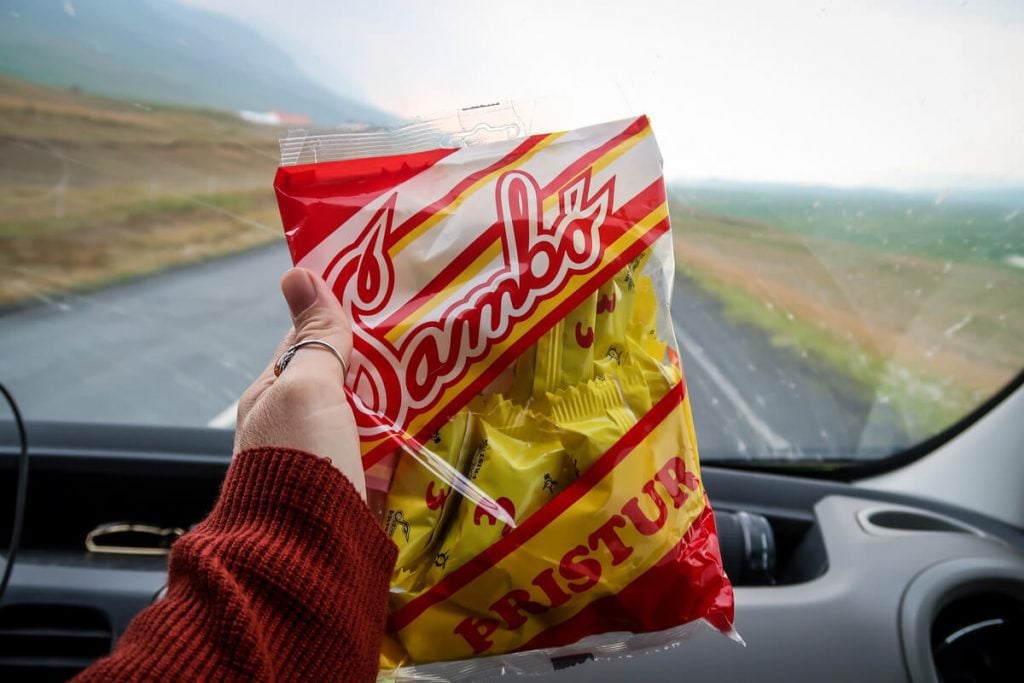
Icelanders sure do love their licorice, and there’s a pretty good reason for it. Because of the harsh climate, the first settlers in Iceland had no sugar or honey, so instead, they used licorice root as a sweetener.
Even though sugar and honey are now abundant in Iceland, the licorice flavor stuck and can be found in all sorts of candies, desserts and even as a popular ice cream flavor.
My mom is a huge black licorice fan and I even found a jar of licorice-infused Icelandic sea salt that I brought back for her. (It’s actually very delicious!)
Where to try it: Any supermarket! You can find an overwhelming amount of licorice in the supermarket candy aisles – from licorice powdered raisins, to salty licorice pieces, to licorice straws and colorful candy-coated licorice bites, Iceland is a licorice-lovers heaven.
Our recommendation: The most popular type is chocolate-covered licorice, and the most beloved brand is Þristur.
In our opinion, it doesn’t have a super strong licorice flavor, but instead tastes kind of like a cross between a 3 Musketeers and a Milky Way. It’s a good one to try if you want to sample the local flavors but aren’t a huge fan of black licorice. (It also makes a great souvenir to bring home and share with friends and family.)
Be sure to pick it up at a supermarket, not a gas station, as we paid more than double the supermarket price at the latter.
12. Kleinur
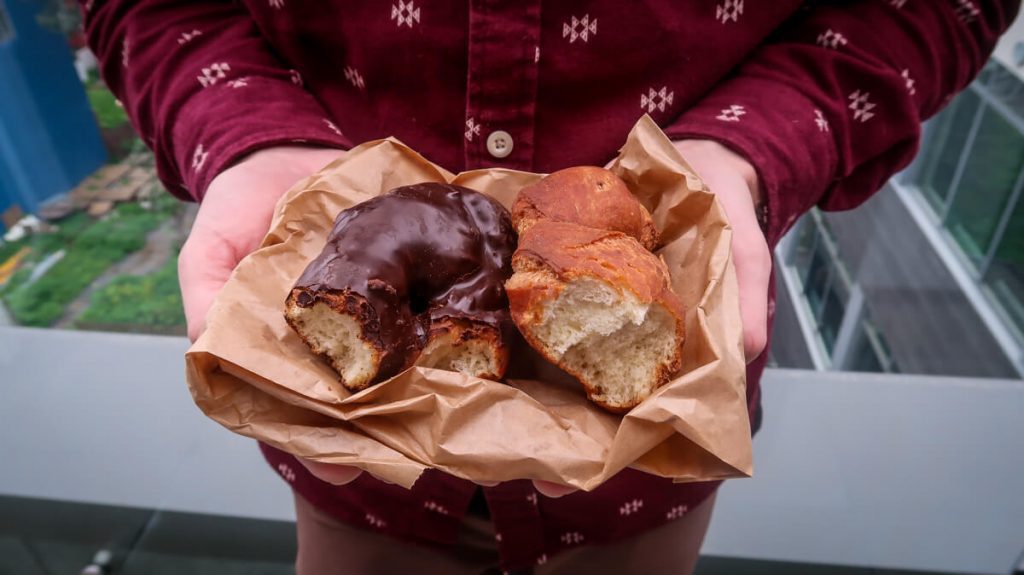
What is it? Twisted doughnut
These twisted doughnuts are a staple at pretty much any traditional bakery (though we didn’t find them at the more modern pastry shops).
They don’t look like much, and honestly, they taste very similar to a plain old fashioned doughnut. Nothing too special here, folks. Just a lightly sweet doughnut.
We preferred the chocolate-covered kleinur to the plain one, because well, chocolate-covered anything is always better. But try both just to compare.
If you’re really into doughnuts, ástarpungar (aka “love balls”) are very similar to kleinur, but are ball-shaped instead of being twisted.
Insider tip: Our advice is to try kleinur, but also try the less traditional pastries from Reykjavík’s Braud and Co. because holy cow, everything we ordered there was incredible. Thank us later.
13. Ice cream
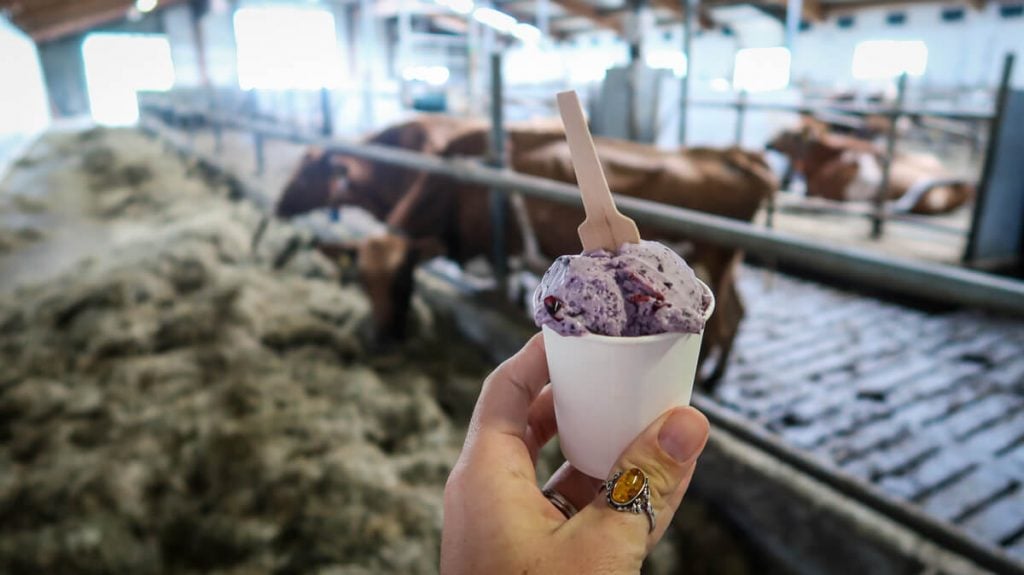
While ice cream isn’t a dish unique to Iceland, it’s worth getting a cone (or two!) during your trip. Even though Iceland is notoriously cold and is rarely what would be considered “ice cream weather”, locals don’t let that stop them from indulging in frozen treats.
All around Iceland, you’ll see creameries (definitely worthy stops along your road trip!) and Reykjavík has a few excellent ice cream parlors as well, serving up high-quality scoops with unique flavor options.
Our favorite ice creams in Iceland:
- Valdis in Reykjavík (there are a couple locations)
- Efstidalur II on the Golden Circle
Looking for something other than a typical cone or dish? Try ordering a bragðarefur. This is kind of like Iceland’s version of a DQ Blizzard or a milkshake. Typically, you’ll choose an ice cream and a few different toppings to have blended together.
Icelandic Drinks
Now that we’ve talked about all the foods to put on your list, here are some drinks to try while in Iceland.
14. Water
While in Iceland, we mostly stuck to drinking water for a few reasons.
- The water in Iceland is some of the purest in the world.
- It is free from the tap, so it saves quite a bit of money.
- We both truly love water!
- I was 6.5 months pregnant on our most recent trip to Iceland, so we weren’t able to indulge in the local spirits as much as we may have in the past.
15. Maltextrakt (malt)
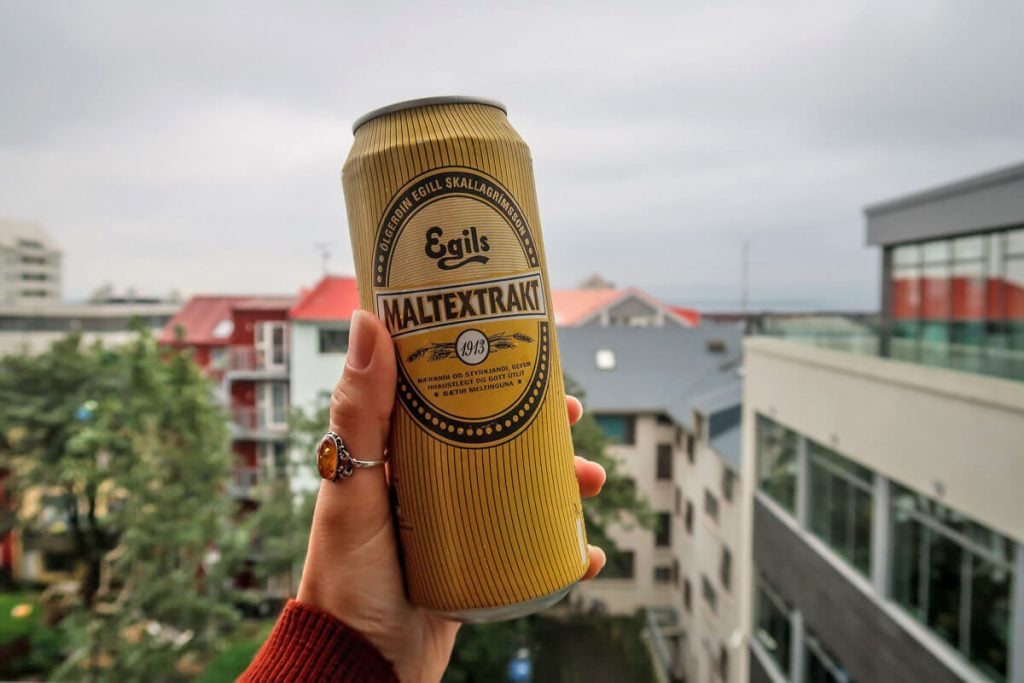
While the can may look like beer, don’t be fooled. This non-alcoholic beverage is carbonated and has a flavor that is reminiscent of caramel, cola and beer. I’ve also heard it described as a sweeter (and non-alcoholic) version of Guiness.
I didn’t think I would like it, but I did enjoy it more than I anticipated.
I should preface this by saying I don’t typically drink soda, and I probably wouldn’t drink an entire can, but it was certainly interesting to taste. Malt has a pretty unique flavor, so even if you’re not a soda drinker (like me!), I’d still recommend giving it a try.
16. Appelsín
This ultra popular Icelandic orange-flavored soda tastes nearly identical to Fanta.
In my opinion, this isn’t a must-try drink on its own as it’s not anything super unique. However, there is a mixture that includes Appelsin that is pretty interesting to try… (more on that below).
17. Malt og Appelsín (aka malt & Appelsín)
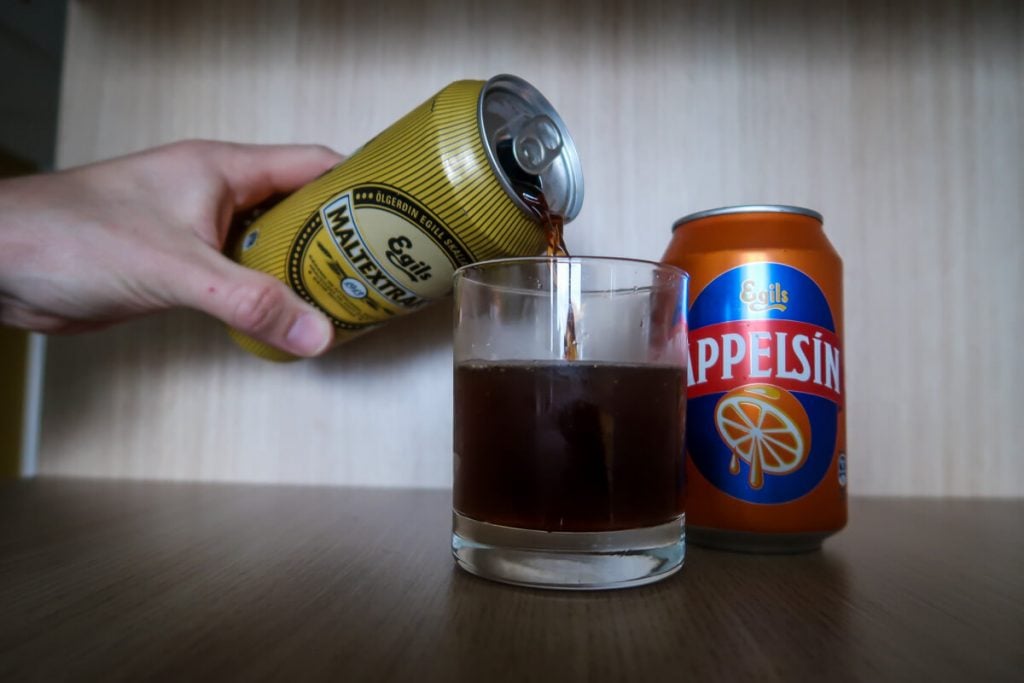
Maltextrakt has been around for more than a century, and it used to be quite expensive. This led to people mixing this sweet dark beverage with other ingredients to stretch it out. Enter “Malt og Appelsín”, the most popular Christmas drink in Iceland.
Fun Fact: This combo is also called Jólaöl (Christmas ale).
It’s just what it sounds like: a combination of Malt and Appelsín, though how you mix it can be up for a bit of debate.
Some people say a 50/50 blend is the way to go, whereas others claim 60% Malt plus $40% Appelsin is the key to the perfect combination. No matter what proportions you go with, one thing is pretty clear – Appelsin should be added to your glass first, then the Malt.
Supposedly, this unique flavor combination is the “taste of home” for many Icelanders.
18. Craft beer
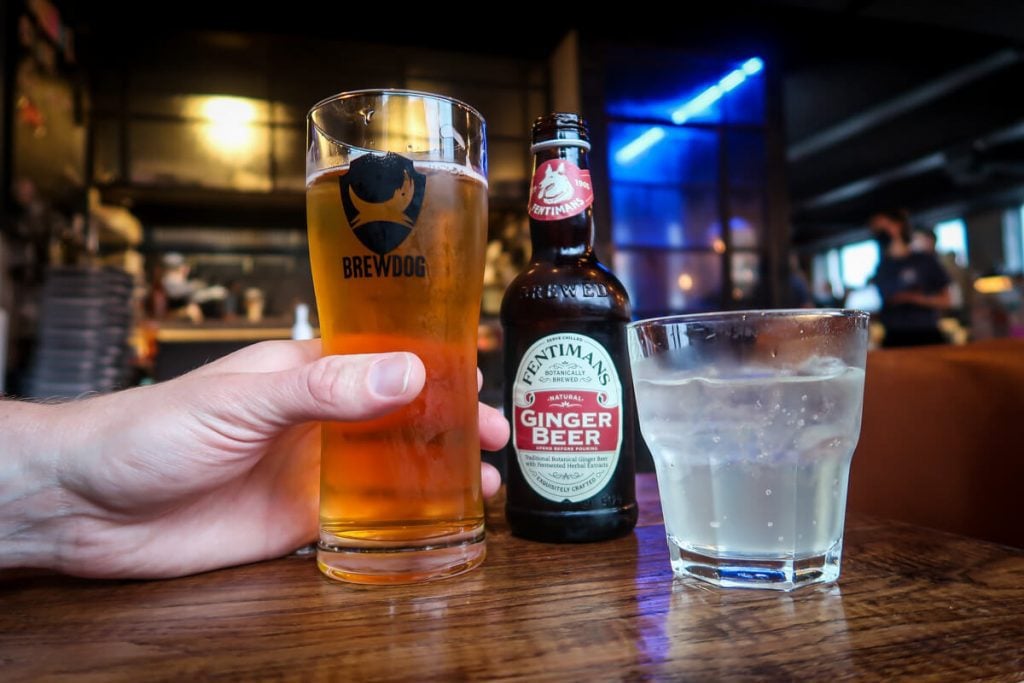
Beer was actually banned in Iceland until 1989 (crazy, huh?!), so the craft beer scene is relatively new, but it’s pretty dang good.
Craft beer is expensive, but if you are looking to sample a few local brews during your time in Reykjavík, here are our recommendations:
- Skuli Craft Bar: This was our favorite place for beer and atmosphere in Reykjavík (their hazelnut porter was excellent, and they have a dart board!).
- BrewDog: Lively atmosphere with lots of young locals, this brew pub has great food and a pretty good beer selection.
- RVK Brewing Company: We didn’t make it here, but it looks like they have excellent craft beers.
19. Icelandic spirits
In the past, alcohol has been heavily regulated and even banned for quite some time. So it shouldn’t come as too much of a surprise that there aren’t a ton of true Icelandic liquors. Here are the most notable:
- Opal or Tópas: Licorice flavored spirits created and named after candies of the same name
- Brennivín: often called “black death”, this liquor is flavored with caraway seeds and is often drunk immediately after eating hákarl (fermented shark)
- Flóki Whiskey: If you’re a whiskey fan, you may enjoy trying Flóki, as it is made from only Icelandic ingredients
Foods to skip in Iceland (and why!)

There are a handful of controversial Icelandic foods that typically make it onto “must try” lists. But we (respectfully) disagree, and we’re going to share why.
For some of these dishes, there is an ethical reason why we’d recommend passing. And for others on this list, it’s not really what locals eat anymore and is instead a “touristy thing to do”, which often comes with a steep price tag.
We’ll spill which dishes to skip so you can save your krona for something much more meaningful.
Hákarl
What is it? Fermented Shark
This one always tops the “must try Icelandic foods” list, so you might be wondering why we have it listed in the section of things not to try…
Well, there are a few reasons:
- It’s not really what Icelanders eat today, and trying it is more or less a “tourist checklist” instead of something locals would really recommend.
- Shark meat contains toxic levels of mercury, and can be dangerous to eat (or for people in sensitive groups). That said, you likely won’t consume more than a 1-square-inch piece of hákarl.
- As we’ve learned more about shark conservation, we personally feel that eating shark isn’t very ethical. Greenland sharks (the type used to make hákarl) are listed by the World Conservation Union as “near threatened”. Before digging in, consider the ethics of eating shark to determine whether or not you want to partake.
- It doesn’t taste good. I mean, did you really expect it to?
While not a common food for Icelanders today, hákarl does hold an important role in history…
Before there was access to food year round, Icelanders used some unique methods to preserve their meats and produce to last through the long and harsh winters. Pickling, salting, fermenting, smoking and drying were all popular methods of preservation. And it’s said that hákarl used to be made by fermenting the meat in urine. Say what?!
If you do decide to try fermented shark during your time in Iceland, just know you are tasting history, not modern Icelandic cuisine.
If you do the Reykjavík Food Walk, there is one stop where you have the chance to try a small cube of hákarl if you so choose.
I personally did not try it because I was pregnant and it contains harmful levels of mercury. But here’s what Ben thought: “It smells worse than it tastes, but it doesn’t taste good. It’s chewy, acrid, and just not really something you need to go out of your way to try.”
In short: If it’s there in front of you and you want to try it, go for it. But we wouldn’t recommend going out of your way or paying a lot of money to taste this dish.
Svið
What is it? Boiled sheep’s head
Being that Iceland has a harsh climate and long winters, it’s easy to see why eating all parts of an animal was necessary throughout history. Svið, or boiled sheep’s head, is a perfect example of this. And if you do eat meat, utilizing as much of the animal as possible is certainly admirable.
That said, there are definitely more appetizing ways to try lamb while in Iceland.
If you want to add to your “unique and bizarre foods” bucket list, this fits the bill. But if you’re looking for a delicious meal that won’t stare back at you, you may want to skip this.
Good to know: Traditionally, Icelanders eat the eyes and tongue too, as to not waste any part of the animal.
Hrútspungar
What is it? Pickled ram’s testicles
I mean, go for it if you really want to have a “unique foodie experience”, but this is yet another dish that used to be eaten out of necessity but is now only on touristy menus.
Our personal advice is to save your money for a splurge-worthy meal at a nice restaurant in Reykjavík that you’ll truly enjoy. And if you think you’ll truly enjoy every bite of testicles that have been boiled and cured in whey, then by all means order up a serving of hrútspungar!
Whale meat
The majority of whale meat sold in Iceland is in restaurants catering to tourists. Truthfully, I’m shocked that this is still happening given its controversial nature and the global initiatives to stop whaling for good.
While Icelanders once ate whale meat out of necessity way back when, it is certainly not something they do today. Instead of ordering a whale steak, go whale watching and appreciate these gentle creatures in a much more meaningful way.
Puffin meat
I hope I don’t really have to explain why this one is controversial. While puffins are not endangered, they are threatened by human activity, and their populations are lower than what they have been in the past.
The only reason you’ll see puffin on the menu is for tourists to feel like they’ve had a “unique Icelandic experience”. But it is not a common food for locals.
Let me just say you can have so many incredibly unique and adventurous experiences in Iceland without eating one of these beloved birds. Please skip the puffin meat and photograph them instead!
Best food experiences in Iceland

We had so much good food in Iceland, and we wanted to share our top recommendations with you so you too can experience the deliciousness.
1. Go on a Reykjavík Food Tour
If we were to recommend one foodie experience in Iceland, this would be it.
You get to sample a huge variety of Icelandic foods in a short amount of time. In fact, after this tour, you will have crossed off a good portion of the foods on our list!
While not cheap, we truly think it’s worth the price for the amount of food you get to try and the experience as a whole. If you were to get each of these dishes on your own, you’d surely end up spending more money, as Icelandic restaurants in general are expensive.

Book your Reykjavik Food Walk Tour here and use the code TWS10 on checkout to get 10% off your tour price!
Our advice: We took this food tour at the very end of our trip, and while it was a great way to end our time in Iceland, we think it would be ideal to book this at the beginning of your time in Iceland if possible. You’ll get to learn about the cuisine and have a feel for which foods you still want to try during your time in the country.
2. Have a langoustine meal
One of the meals we keep talking about is our langoustine dinner at Fjöruborðið. It was a splurge, but well worth it.
3. Try an Icelandic hot dog
I wasn’t completely sold on this idea – I’ve already admitted I’m not a huge fan of hot dogs in general – but I’ve gotta say I was quite impressed with Iceland’s take on this dish. And trying it at the famed Bæjarins Beztu Pylsur is a pretty cool experience in itself.
4. Eat ice cream at a creamery in town

We had a lot of fun stopping at a couple of creameries around the country and sampling their ice cream – straight from the source!
Here are a few creameries to have on your radar:
- Efstidalur II (on the Golden Circle)
- Erpsstaðir Creamery (near the Snæfellsnes Peninsula)
- Kaffi kú (near Akureyri), only open during the summer
5. Experience fine dining in Reykjavík
If you have some wiggle room in your budget, we’d recommend planning out a “splurge meal” in Reykjavík as there are so many truly incredible restaurants in this city.
Here are some of the recommendations from our foodie friend who lives in Reykjavík:
Important: Most of these restaurants require reservations, so be sure to book your table in advance.
Where we ate: On the recommendation of our friend who lived in Reykjavík, I’ve dined at Apótek twice. Once with my mom in 2019, and again in 2021 with Ben. (I raved so much about this meal that Ben had to try it!)
If you decide to eat at Apótek, you should definitely save room for dessert. The Double Passion dessert is unlike anything I have ever had and I honestly can’t even describe how good it is. I ordered it both times I ate at Apótek and it was just as good as I remembered. Just order it and thank us later!
Money-saving tip: We picked up a Visitor’s Guide booklet at the beginning of our trip and saw that there was a 20% off coupon which saved us quite a bit on our total bill. (There were a handful of other nice Reykjavík restaurants in there too.) You can find these booklets at hotels, car rental agencies, tour companies, the airport, etc.
6. Eat tomato soup in a greenhouse
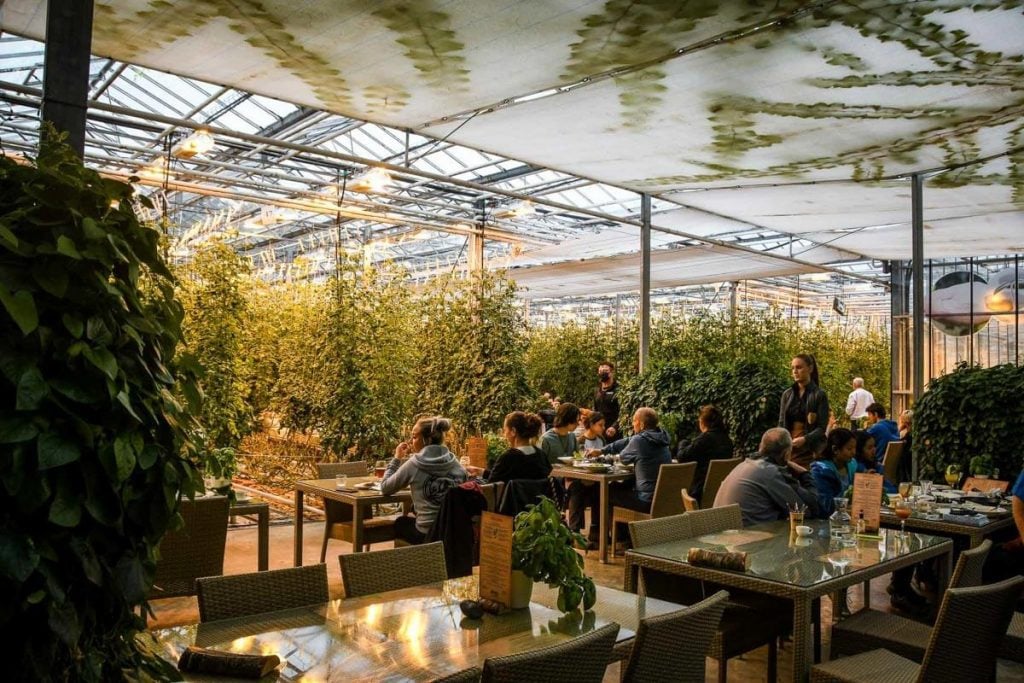
Along the Golden Circle, Friðheimar makes a unique and memorable lunch stop. Dine on dishes made with fresh tomatoes grown in the greenhouse in which you’re seated, and watch bees as they fly about pollinating the plants.
You can even cut fresh basil from a plant on your table to add to your meal. It’s a pretty special dining experience!
While this is not part of the traditional “Golden Circle itinerary”, it is by no means a secret.
You will definitely want to make a reservation as they get fully booked, especially during peak tourist season.
What to order:
- Friðheimar is famous for their tomato soup (which has unlimited refills), so definitely get a bowl. It’s fantastic.
- Fresh tomatoes and homemade burrata (served with the best coarse sea salt I’ve ever had!). This is a nice complement to the tomato soup since you’ll be able to experience them in their natural (aka freshest!) state.
- The ravioli with tomato sauce also looked good!
- We saw lots of people with their signature Bloody Marys.
- Cheesecake with green tomato jam. Sounds weird, but it’s sooo good. The green tomato jam is tart and sweet and almost tastes like a kiwi.
7. Try cooking in your campervan
Honestly, some of our favorite meals in Iceland were the ones we cooked ourselves and could enjoy with beautiful views outside.
If you plan to camp in Iceland, you’ll likely be cooking many of your own meals, and we have tons of tips and recipe ideas for you here.
→ Psst! Looking for a campervan rental? We put together a HUGE Iceland campervan rental guide, including the company we’d recommend and an exclusive discount for our readers!
8. Rye bread tasting at the Geothermal Bakery at Laugarvatn Fontana
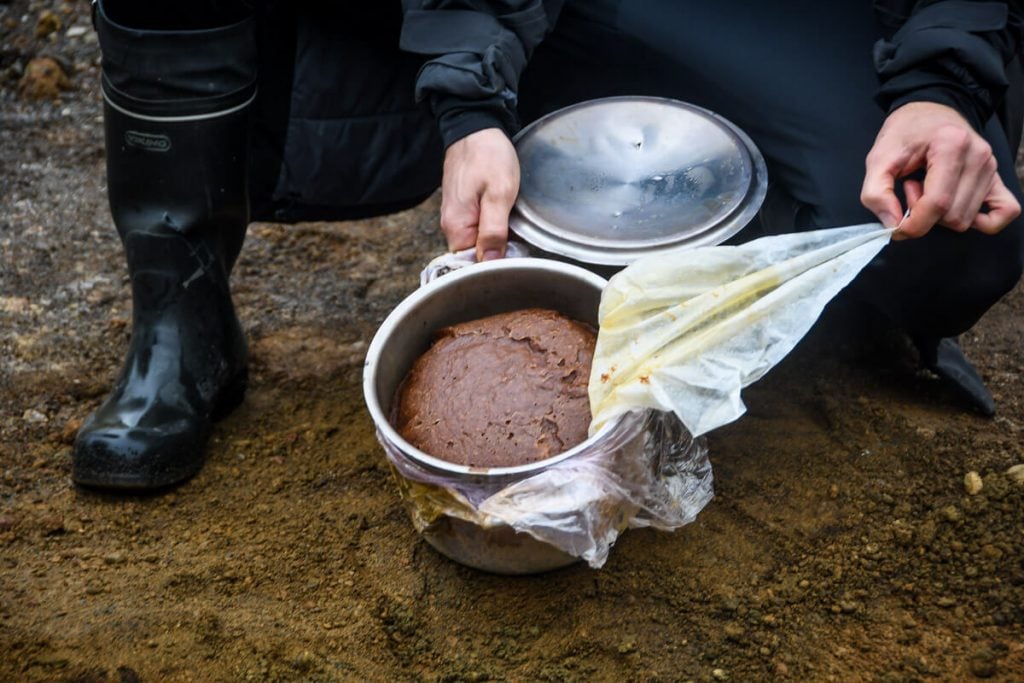
After seeing Laugarvatn Fontana on Netflix’s Down to Earth, we added the geothermal bread tour to our Iceland itinerary and it ended up being a highlight of our trip.
Watching how they bake rye bread underground using geothermal heat was fascinating, and the unlimited warm bread (plus smoked trout) was hands-down the best we had in Iceland.
The 30-minute tour runs daily at 11:45 am and 2 pm (plus an added tour at 10:15 am during the summer months), so you’ll need to plan your route accordingly.
Good to know: There are also geothermal baths on the property that look nice and not all that crowded. We opted to skip these as we already had many other places we wanted to visit on the Golden Circle, and it would have been too tight to squeeze it in.
Restaurants in Reykjavík
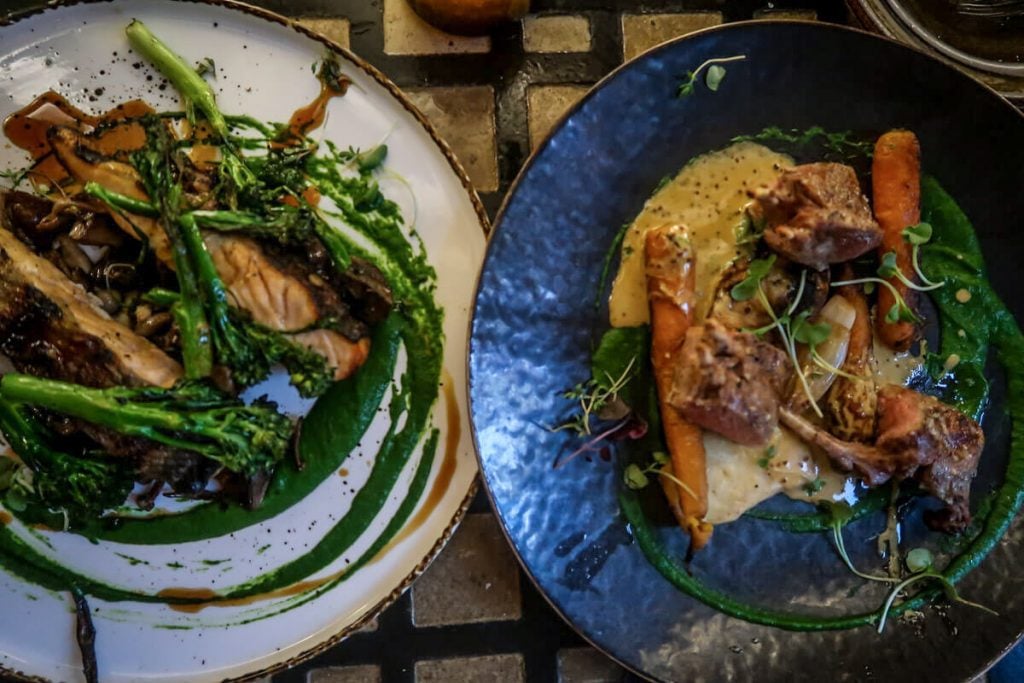
Here are some of our top (personal) recommendations for eating out in Reykjavík.
- Reykjavík Street Food: Inexpensive versions of traditional Icelandic fare in a casual setting.
- Braud and Co.: Amazing pastries! We went here twice and tried to go a third time but they had closed. Do yourself a favor and order several items.
- Apótek: Fine dining, excellent cocktails and out-of-this-world desserts.
- Bæjarins Beztu: Small stand famous for serving the best Icelandic hot dogs in town (and maybe even the country).
- Svarta Kaffið: This cozy shop serves two seriously good soups each day – one with meat and one that is vegetarian.
- Cafe Loki: Located next to the Hallgrímskirkja church, this is a popular spot for tourists to try traditional Icelandic dishes. Try the rye bread ice cream!
- BrewDog: For a fun dinner out surrounded by locals, this is a good choice. Their beer is expensive (as is most craft beer in Iceland), but really good. And the “Lambstrami Sandwich” was excellent and generously portioned.
- Messinn: Their Arctic Char dish is out of this world good!
Other notable restaurants around Iceland
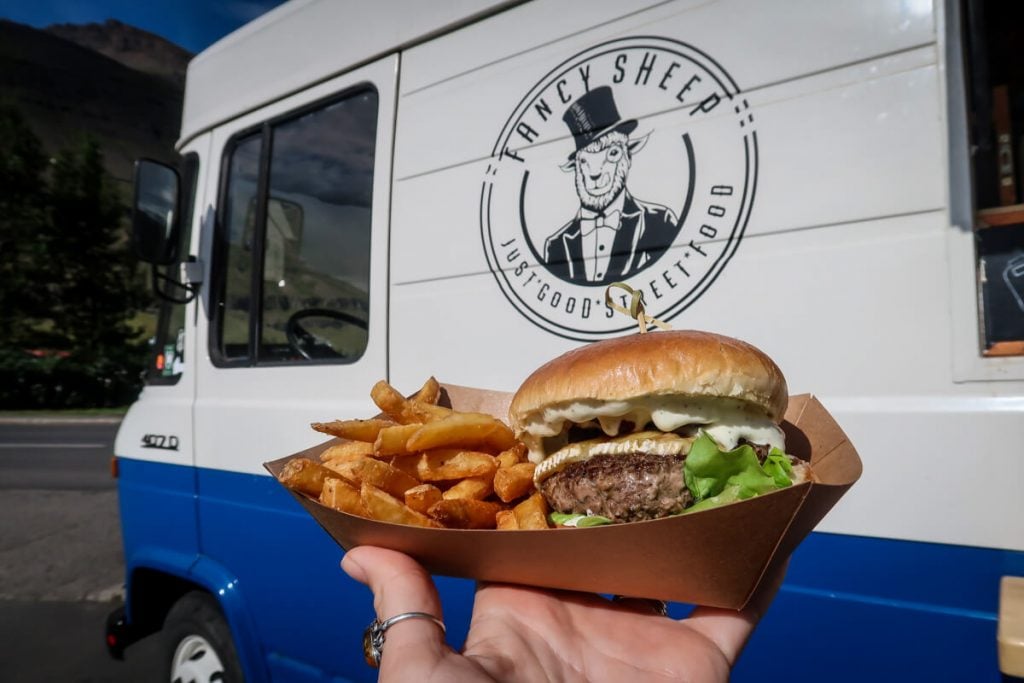
Here are the restaurants we personally ate at and loved. We ate at more places during our trip, but we’re only mentioning ones we would highly recommend:
- Friðheimar for fresh tomato dishes in a greenhouse setting
- Fjöruborðið for a memorable langoustine dinner
- Fancy Sheep food truck in Seydifjordur for their lamb burger
- Fish and Chips in Husavik
- The Soup Company in Vik for the Lava Soup in a bread bowl
Two restaurants on our list for next time:
- Pakkhús Restaurant in Hofn: our foodie friend who lives in Reykjavík highly recommended this restaurant for a splurge meal
- Tjöruhúsið in the Westfjords: This seafood restaurant has been listed as one of the best restaurants in the world. If you make it up to this region be sure to give this place a try and let us know how it is!
Tips for vegetarians in Iceland
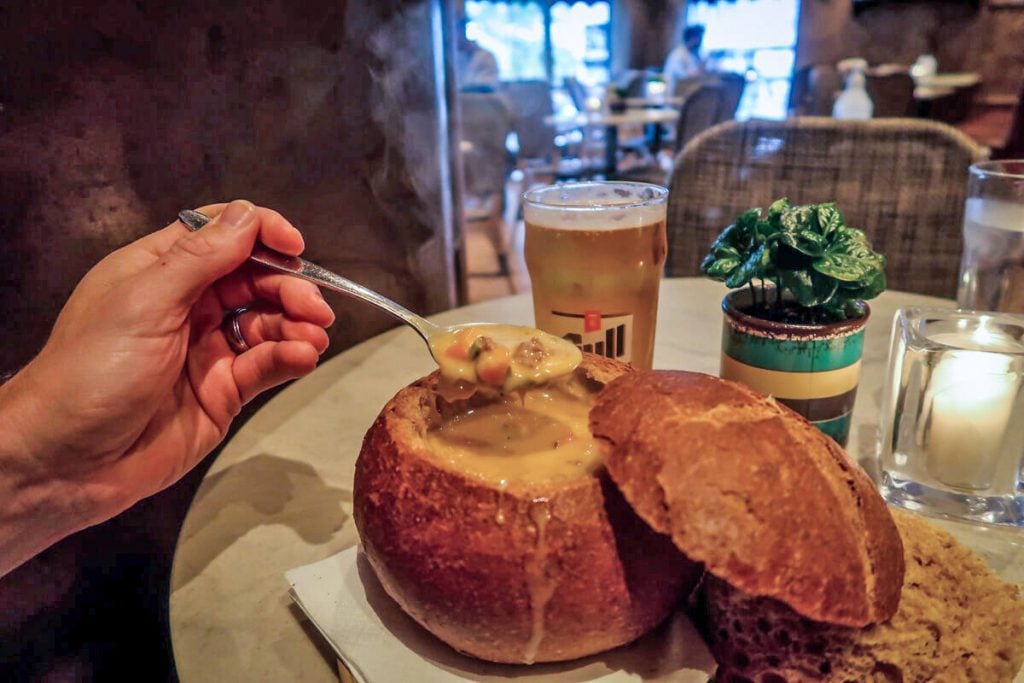
- Ask for the soup of the day. Oftentimes there is a vegetarian option.
- Eat your way around Reykjavík. There are plenty of restaurants that cater specifically to vegetarians and vegans in this modern city.
- Cook your own meals. If you’re camping, you’ll be able to cook some meals for yourself and have a bit more control over the ingredients. We’ve got a whole article to help you with your cooking and grocery shopping in Iceland.
Insider tip: In the freezer aisle of most supermarkets, you’ll find different types of meat alternatives, from veggie patties to falafel.
Perfect Iceland itinerary
Want to skip the stress of trip planning?
Planning a trip to Iceland can feel overwhelming—there’s so much to see, and it’s easy to miss hidden gems if you don’t know where to look. That’s why we created our done-for-you Iceland South Coast Itinerary—so you can spend less time researching and more time soaking in Iceland’s epic landscapes.

This 7–day itinerary takes you along Iceland’s breathtaking southern coast, blending adventure with a touch of luxury. You’ll visit iconic sights like Skogafoss and Diamond Beach, plus off-the-beaten-path spots most tourists miss (like a hidden waterfall that’s one of our all-time favorites!).
With detailed daily plans, insider tips, driving directions, and hand-picked stays, this guide takes the guesswork out of planning so you can experience Iceland stress-free.
Iceland map: Our favorite spots!
Want to upgrade your experience in Iceland?
Maybe itinerary planning isn’t your thing and you’d rather have the freedom to just wing it?
We’ve created a fully interactive, custom map of Iceland that includes all our favorite recommendations and hidden gems.
We’re talking everything in this article—-plus all of our personal recommendations, restaurants, hidden gems, viewpoints and unique stays.
If you prefer to navigate like a local rather than planning every detail yourself, this map is the perfect next step.
Plan your trip to Iceland
We have TONS of resources on travel in Iceland and how to make the most out of your trip. Check out our Iceland Homepage for all the answers to your most burning questions, or read some of our favorite articles below.
- Check out all of our top recommendations for things to do in Iceland.
- Get a complete cost breakdown for your Iceland trip and follow our sneaky budget tips to save money!
- Save this list of cool Iceland Airbnbs for when you’re ready to book your accommodation.
- And don’t forget camping in Iceland is one of the best ways to save money!
- You’ll want to keep this guide handy if you plan on driving Iceland’s Golden Circle.
- Read up on all the actually cool things to do in Reykjavik.
- Be sure to download these essential Iceland travel apps before your trip!
Don’t miss your chance to grab our Iceland packing list!
Click the banner to download our complete packing list for Iceland! It’s packed with good suggestions and insider tips to help plan your Iceland trip.
And it’s completely FREE, so why not!?
Save this article on Pinterest for later!
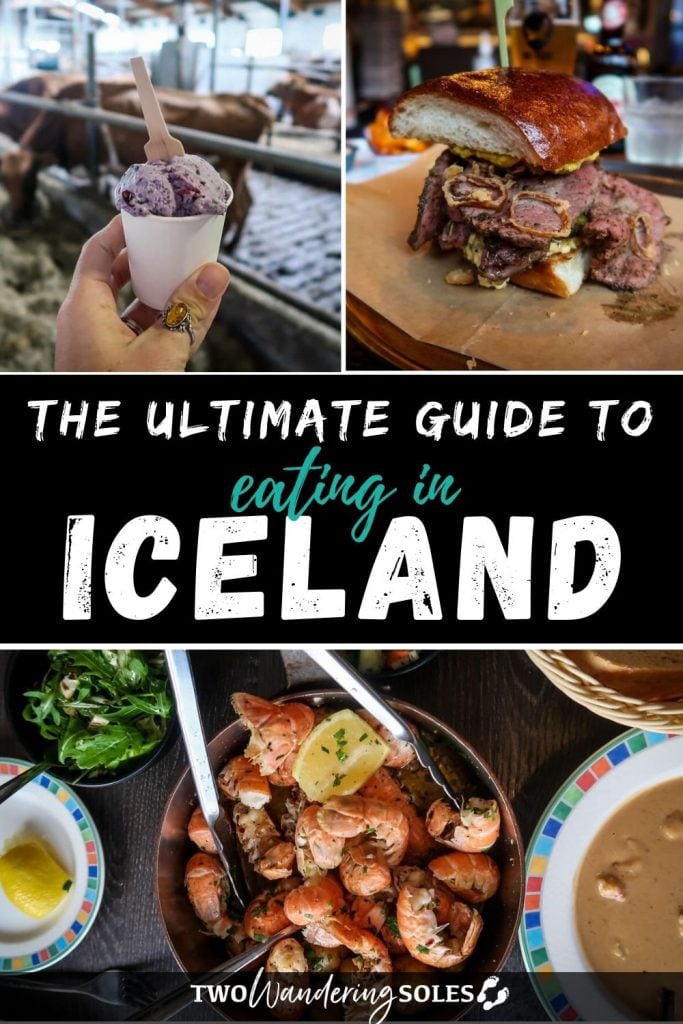
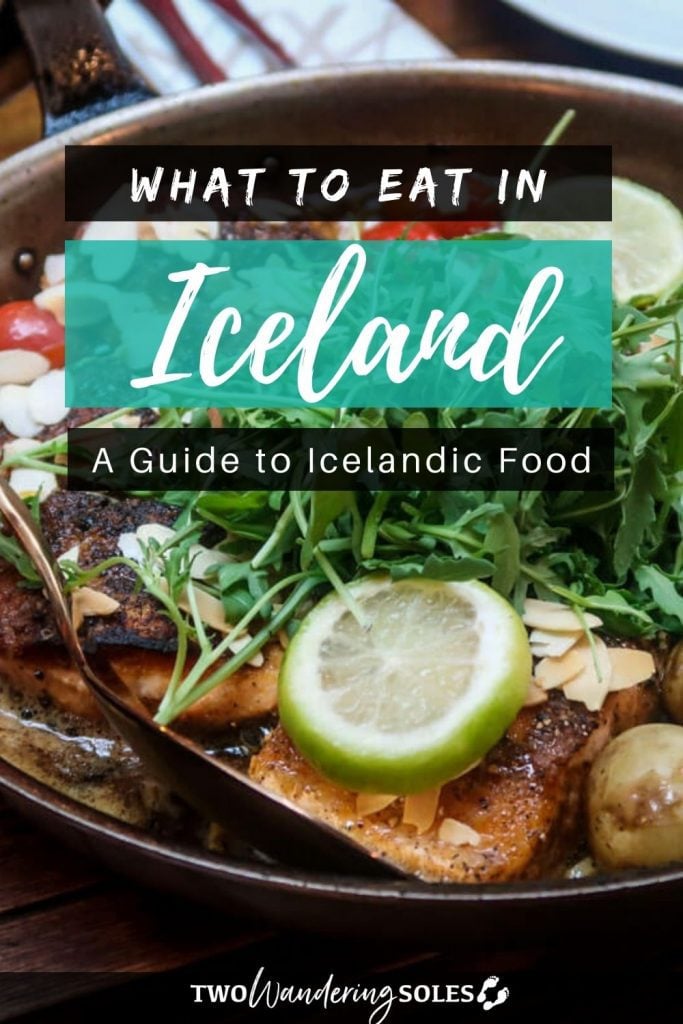
Still have questions?
What else are you wondering about Icelandic food? Comment below and we’ll do our best to help!



Fantastic read—thanks for sharing! Keep it up, I’m excited for more of your amazing posts.
Thanks for the encouragement!
Really appreciate the effort you put into this article.
Amazing blog. Thanks for Sharing.
Nice Post, I found it really amazing, Keep Sharing.
One of the best things about traveling is definitely the food! I love this guide – I’d probably try everything on the list. The fish jerky sounds especially intriguing! But I think I’ll pass on the fermented shark – that’s a definite no for me!
One of the best parts about travel is the food! Love this guide – I would probably try each of these – the fish jerky really intrigues me! Totally staying away from fermented shark – that’s a big no from me!
I love doing food “research” when I travel! I had a great time trying different foods when I traveled to Iceland too. I really liked the lamb and the Icelandic lobster. I didn’t try Hákarl though. Part of me wished I gave it a try, but at least I didn’t miss something that tasted good! Thanks for all the restaurant ideas. I am saving your post for the next time I visit Iceland.
What a great food guide! thanks you for sharing!
I have actually seen many people being fond of Licorice. And I always wondered why? You gave me yet another reason to try that out 🙂
Arctic Char sounds amazing & I’d love to try Icelandic fish & chips! Some great suggestions here for when I can get to Iceland. I’ll save this for later!
Yum, what an amazingly in-depth article on Icelandic food, looks like you guys did some serious research! Thank you for your service.
Great post! I love Iceland and enjoyed many of those foods and was surprised at how many I had never tried before going!